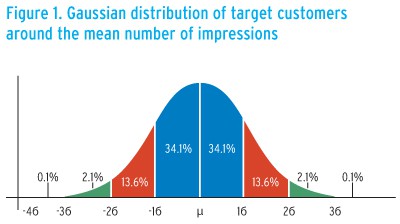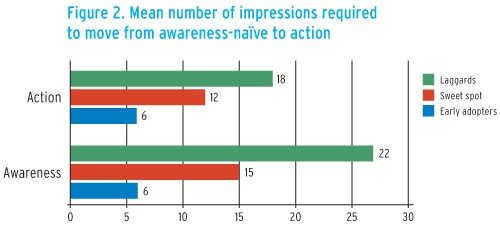
Take a look at the typical Gaussian distribution of our customers (see Figure 1). This graph shows that 95 per cent (red + blue areas) are two standard deviations from the mean number of impressions required to move from awareness-naïve to action, which we define as writing a prescription (Rx). Now look at Figure 2, which actually provides some parameters around the mean number of impressions for three target segments of our customer base: early adopters, the sweet spot and laggards.
- For 95.4 per cent of our clinicians, it takes approximately 27 impressions to get from awareness-naïve to action
- 2.3 per cent (green area) of our clinicians (laggards), require such a high number of impressions to drive action that the cost of pursuing the low number of prescriptions they will generate is simply not worth it
- 2.1 per cent (green area) of our clinicians (early adopters), typically form the segment we describe as key opinion leaders (KOLs) and don’t require ‘promotional effort’ as we define it.
Target audience
According to a British Medical Association (BMA) briefing, there are 42,000 GPs in the UK. This means in that market 2,100 of your target customers (5 per cent) should not warrant any promotional activity, either because they represent the slow-to-change laggards or else are those early adopters who have already read the trial results or participated in the multi-centre studies as site investigators.
That leaves about 40,000 GPs upon which to focus your promotional efforts. Figure 1 shows 47.7 per cent of your target customers are above the mean number of impressions (27) required to move from awareness-naïve to action. This represents close to 20,000 doctors who require a higher number of ‘touches’ or impressions. Here, you should think carefully about the 13.6 per cent (red area) and about half of the 34.1 per cent (blue area) who will require in the order of 35 impressions to begin regularly writing an Rx for your product.
If you ascribe to this maths then you quickly realise that a whopping 30 per cent of your customer base (red + half the blue area above the mean) will not yield the return on marketing activity in a reasonable amount of time required to drive market share. And this does not include the 2.2 per cent (green area and beyond), which we have already factored out.
This means that for any given therapeutic area with any given number of clinicians, the total addressable promotional market is around 65 per cent of prescribing clinicians.
Closer look
What are the weaknesses of this model? Firstly, there is really no hard-and-fast rule around the mean number of impressions for the ‘sweet spot’. For example, differing therapeutic areas, or treatment saturated vs. treatment unsaturated markets, do not all take 27 impressions to drive adoption. Secondly, impressions are defined in different ways and have different weightings, which are not accounted for here. A journal ad vs. a sales representative’s visit vs. an advisory board meeting are all impressions, but with different weights. Thirdly, this model assumes that the ‘sweet spot’ for every therapeutic area is 95 per cent of the total; there are instances where the number of early adopters or laggards is close to 20 per cent, rendering the true ‘sweet spot’ at about 80 per cent of the total.
So, what are the implications for healthcare commercial leaders today? As a starting point, organisations need to re-evaluate sales call activity and frequency. At 10-12 calls per year on the highest prescribing doctors, combined with all other impressions, it will take approximately 18 months to drive significant prescription volume. We need to find ways to increase the number of impressions on the top 65 per cent of our customer base and shorten the time to the magic number of 27. Secondly, it is imperative that we start using our in-house CRM systems to mine our own data and tally the number of impressions each one of our physicians has received and correlate those numbers with prescriber-level data. Lastly, we need to find new ways of creating impressions.
The field, as I have coined the term, of ‘impression marketing’ is relatively new in healthcare, but it is pivotal to the success of a new wave of healthcare marketers who embrace the notion that in marketing, like many of the pure sciences, the numbers never lie.







